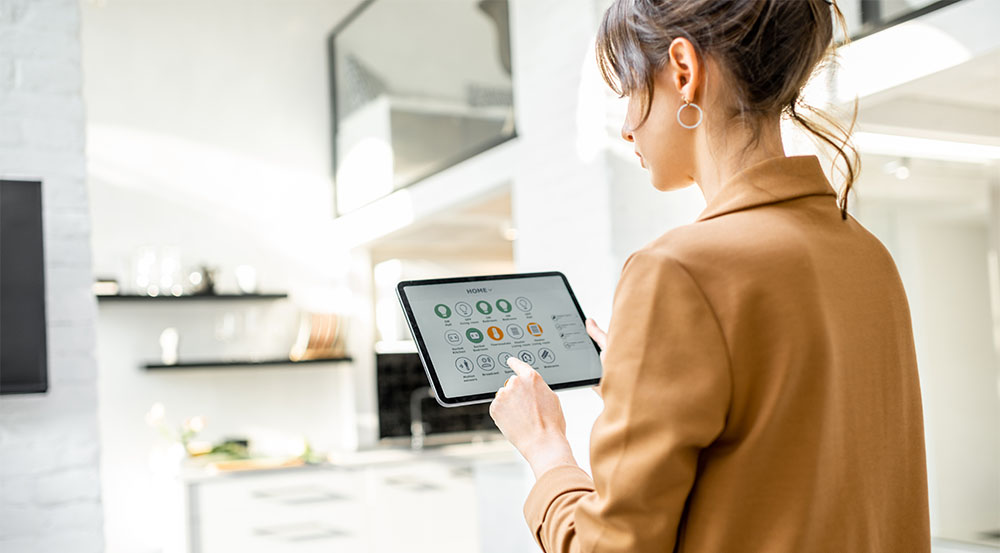Soaring energy bills. More and more evidence of human-influenced climate change. The argument for creating a sustainable home has never been stronger.
Many of us already do the basics like sorting the recycling from the rubbish, reducing single-use plastics and turning off the tap while brushing our teeth. However, the most significant way to create a more sustainable home is by reducing energy consumption. Energy plays a major role in Australian households. By adopting more energy-efficient appliances and technologies, switching to renewables and changing behaviour to reduce energy consumption, you will reduce greenhouse gases and save yourself some money on your power bills.
Here are six ways you can start creating a more sustainable home.
Get connected with a smart home hub
A smart hub is essentially a master control for every smart device in your house. Appliances and technology can be controlled automatically and remotely in a connected home using your phone or home internet connection. It’s not just about convenience, though. A smart home hub can be part of your energy-saving plan.
You can connect your smart home hub to all sorts of things in your home, such as lighting, heating, cooling, appliances and your hot water system. You can turn things on or off remotely or put them on a schedule to take advantage of off-peak power.
Smart bulbs are a great place to start because it’s as easy as replacing a light bulb. Other great starting options are smart thermostats and smart ceiling fans. Many of these will learn your habits and how long it will take to heat or cool your home and turn themselves on and off accordingly.
Switch to energy-efficient lighting
Energy-efficient lighting technology has come along in leaps and bounds in the last few years. Making the switch to LED lighting is one of the easiest ways to reduce your energy consumption and save money on your power bill.
Almost any type of light bulb can be replaced with an LED light now, including downlights. Not only do they use 75% less electricity, but they also last 25 times longer than old-fashioned incandescent light bulbs.
Install a smart meter
A smart meter is a digital electricity meter that records your electricity usage in at least 30-minute intervals and sends it directly to your service provider. Your energy usage data is also available for you to view via your energy retailer’s app or an in-home display. This information can help you be more energy conscious.
A smart meter shows household energy usage patterns. This can be useful to help you reduce the energy used during peak times when power is more expensive. It can also help you decide what size solar system to install if that is on the cards.
All homes in Victoria now have smart meters, and since 2017 they have been the default for any new or replacement meters in other states. Talk to your energy retailer to find out how to get a smart meter.
Go solar
If you can, go solar. Adding solar panels has proven to be an excellent investment for your property. Houses with solar panels fetch a premium on the market as people seek to reduce their energy bills and carbon footprint.
There are a couple of things to consider when deciding to go solar. Most importantly, how much sun will the panels get? To capture the most sunlight, your panels should be unshaded and face north or northwest.
Insulate your home properly
A well insulated home helps to maintain a comfortable temperature inside so that you use less energy to heat or cool a space. A good place to start is in the walls and your ceiling. If you can access the space under your floor, consider underfloor insulation too.
If you’re building a new home or an extension, be sure to research the different types of insulation available and choose one that is appropriate for your climate. Spending a little extra on insulation at the outset will save you thousands in years to come.
Consider passive design
Heating and cooling systems are typically the largest energy user in Australian homes. Good passive design will ensure your home is both comfortable and energy-efficient. Passive design takes advantage of natural sources of heating and cooling to reduce your reliance on man-made climate control.
In the winter months, it lets in the winter sun and ensures that the building keeps the heat inside. Passive cooling techniques cool both the house and the people in it using air movement, evaporative cooling and thermal mass.
Talk to your architect or builder about passive design if you are building a new home or extension. Adopting a thoughtful design that works with the local climate to maintain a comfortable temperature within the home will significantly reduce your future energy consumption and save you thousands in the long term.
